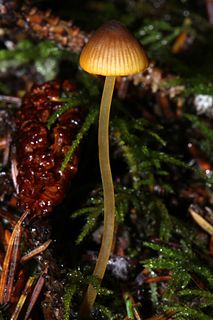
Marie-Louise Damien, better known by the stage name Damia, was a French singer and actress.
Damià Abella Pérez, known simply as Damià, is a Spanish retired professional footballer who played as a full back.

Damia's Children is a 1993 science fiction novel by American writer Anne McCaffrey, forming part of the Talent series. Damia's Children forms a two-part story with the novel Lyon's Pride.
Damias is a genus of moths in the family Erebidae. The genus was erected by Jean Baptiste Boisduval in 1832.

Mycena aurantiomarginata, commonly known as the golden-edge bonnet, is a species of agaric fungus in the family Mycenaceae. First formally described in 1803, it was given its current name in 1872. Widely distributed, it is common in Europe and North America, and has also been collected in North Africa, Central America, and Japan. The fungus is saprobic, and produces fruit bodies (mushrooms) that grow on the floor of coniferous forests. The mushrooms have a bell-shaped to conical cap up to 2 cm (0.8 in) in diameter, set atop a slender stipe up to 6 cm (2.4 in) long with yellow to orange hairs at the base. The fungus is named after its characteristic bright orange gill edges. A microscopic characteristic is the club-shaped cystidia that are covered with numerous spiky projections, resembling a mace. The edibility of the mushroom has not been determined. M. aurantiomarginata can be distinguished from similar Mycena species by differences in size, color, and substrate. A 2010 publication reported the discovery and characterization of a novel pigment named mycenaaurin A, isolated from the mushroom. The pigment is responsible for its color, and it has antibiotic activity that may function to prevent certain bacteria from growing on the mushroom.
Damias aenea is a moth of the family Erebidae. It is found in New Guinea.
Damias biagi is a moth of the family Erebidae. It is found in New Guinea.
Damias choiseuli is a moth of the family Erebidae. It is found on the Solomon Islands.
Damias esthla is a moth of the family Erebidae.
Damias insignis is a moth of the family Erebidae. It is found on the Solomon Islands.
Damias isabella is a moth of the family Erebidae. It is found on the Solomon Islands.
Damias marginipuncta is a moth of the family Erebidae. It is found in New Guinea.
Damias metallica is a moth of the family Erebidae. It is found in New Guinea.
Damias monoleuca is a moth of the family Erebidae. It is found on Goodenough Island.
Damias peculiaris is a moth of the family Erebidae. It is found in New Ireland.
Damias peraffinis is a moth of the family Erebidae. It is found in New Guinea.
Damias postexpansa is a moth of the family Erebidae. It is found in New Guinea.
Damias pseudaffinis is a moth of the family Erebidae. It is found in New Guinea.
Damias shawmayeri is a moth of the family Erebidae. It is found in New Guinea.
Damias szetschwana is a moth of the family Erebidae. It is found in China (Szechuan).


